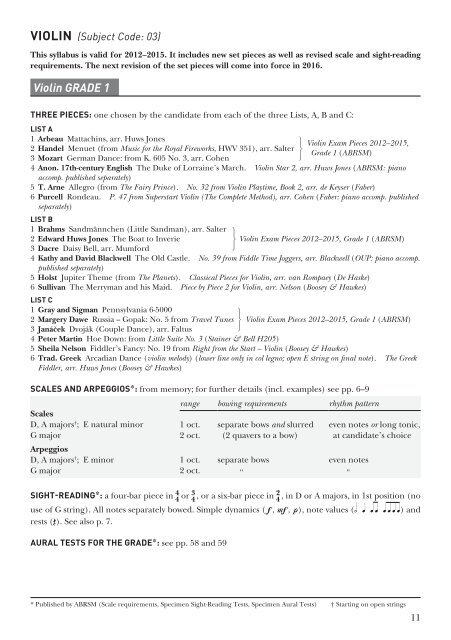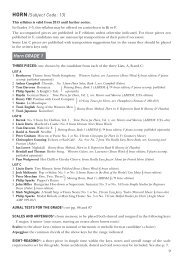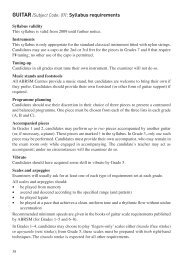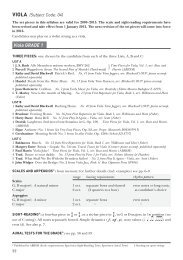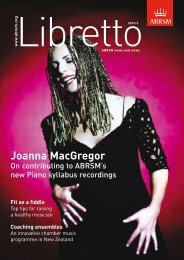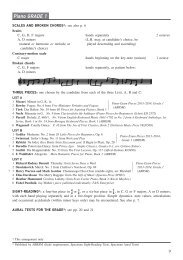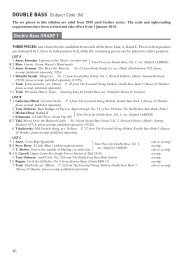You also want an ePaper? Increase the reach of your titles
YUMPU automatically turns print PDFs into web optimized ePapers that Google loves.
VIOLIN (Subject Code: 03)<br />
This syllabus is valid for <strong>2012</strong>–2015. It includes new set pieces as well as revised scale and sight-reading<br />
requirements. The next revision of the set pieces will come into force in 2016.<br />
<strong>Violin</strong> <strong>GRADE</strong> 1<br />
THREE PIECES: one chosen by the candidate from each of the three Lists, A, B and C:<br />
LIST A<br />
1 Arbeau Mattachins, arr. Huws Jones ¸ <strong>Violin</strong> Exam Pieces <strong>2012</strong>–2015,<br />
2 Handel Menuet (from Music for the Royal Fireworks, HWV 351), arr. Salter ˝<br />
Grade 1 (ABRSM)<br />
3 Mozart German Dance: from K. 605 No. 3, arr. Cohen<br />
˛<br />
4 Anon. 17th-century English The Duke of Lorraine’s March. <strong>Violin</strong> Star 2, arr. Huws Jones (ABRSM: piano<br />
accomp. published separately)<br />
5 T. Arne Allegro (from The Fairy Prince). No. 32 from <strong>Violin</strong> Playtime, Book 2, arr. de Keyser (Faber)<br />
6 Purcell Rondeau. P. 47 from Superstart <strong>Violin</strong> (The Complete Method), arr. Cohen (Faber: piano accomp. published<br />
separately)<br />
LIST B<br />
1 Brahms Sandmännchen (Little Sandman), arr. Salter ¸<br />
2 Edward Huws Jones The Boat to Inverie ˝ <strong>Violin</strong> Exam Pieces <strong>2012</strong>–2015, Grade 1 (ABRSM)<br />
3 Dacre Daisy Bell, arr. Mumford<br />
˛<br />
4 Kathy and David Blackwell The Old Castle. No. 39 from Fiddle Time Joggers, arr. Blackwell (OUP: piano accomp.<br />
published separately)<br />
5 Holst Jupiter Theme (from The Planets). Classical Pieces for <strong>Violin</strong>, arr. van Rompaey (De Haske)<br />
6 Sullivan The Merryman and his Maid. Piece by Piece 2 for <strong>Violin</strong>, arr. Nelson (Boosey & Hawkes)<br />
LIST C<br />
1 Gray and Sigman Pennsylvania 6-5000<br />
¸<br />
2 Margery Dawe Russia – Gopak: No. 5 from Travel Tunes ˝ <strong>Violin</strong> Exam Pieces <strong>2012</strong>–2015, Grade 1 (ABRSM)<br />
3 Janáček Dvoják (Couple Dance), arr. Faltus<br />
˛<br />
4 Peter Martin Hoe Down: from Little Suite No. 3 (Stainer & Bell H205)<br />
5 Sheila Nelson Fiddler’s Fancy: No. 19 from Right from the Start – <strong>Violin</strong> (Boosey & Hawkes)<br />
6 Trad. Greek Arcadian Dance (violin melody) (lower line only in col legno; open E string on final note). The Greek<br />
Fiddler, arr. Huws Jones (Boosey & Hawkes)<br />
SCALES AND ARPEGGIOS*: from memory; for further details (incl. examples) see pp. 6–9<br />
range bowing requirements rhythm pattern<br />
Scales<br />
D, A majors † ; E natural minor 1 oct. separate bows and slurred even notes or long tonic,<br />
G major<br />
Arpeggios<br />
2 oct. (2 quavers to a bow) at candidate’s choice<br />
D, A majors † ; E minor<br />
1 oct. separate bows<br />
even notes<br />
G major<br />
2 oct. "<br />
"<br />
SIGHT-READING*: a four-bar piece in 4 4 or 3 4 , or a six-bar piece in 2 4 , in D or A majors, in 1st position (no<br />
use of G string). All notes separately bowed. Simple dynamics (f, F, p), note values (h q qq qqqq) and<br />
rests (Π). See also p. 7.<br />
AURAL TESTS FOR THE <strong>GRADE</strong>*: see pp. 58 and 59<br />
* Published by ABRSM (Scale requirements, Specimen Sight-Reading Tests, Specimen Aural Tests) † Starting on open strings<br />
11
<strong>Violin</strong> <strong>GRADE</strong> 2<br />
THREE PIECES: one chosen by the candidate from each of the three Lists, A, B and C:<br />
LIST A<br />
1 Handel March by Mr Handel<br />
¸<br />
2 A. Holborne The Honeysuckle, arr. Huws Jones ˝ <strong>Violin</strong> Exam Pieces <strong>2012</strong>–2015, Grade 2 (ABRSM)<br />
3 Járdányi French Troubadour Song<br />
˛<br />
4 Byrd Wolsey’s Wilde. Piece by Piece 2 for <strong>Violin</strong>, arr. Nelson (Boosey & Hawkes)<br />
5 Lully Gavotte. No. 12 from Festive Baroque – <strong>Violin</strong>, arr. van Beringen (De Haske)<br />
6 Mozart Little Song (from Nannerl’s Notebook). No. 3 from Magical Mozart, arr. Watkin (Fentone)<br />
LIST B<br />
1 Schubert Heidenröslein (Little Briar-Rose), D. 257, arr. ABRSM ¸ <strong>Violin</strong> Exam Pieces <strong>2012</strong>–2015,<br />
2 Rossini Theme from William Tell, arr. Cohen ˝<br />
3 Trad. Irish Londonderry Air, arr. Huws Jones<br />
˛<br />
Grade 2 (ABRSM)<br />
4 Haydn Theme from ‘Kaiserquartett’, Op. 76 No. 3. Classical Pieces for <strong>Violin</strong>, arr. van Rompaey (De Haske)<br />
5 Mendelssohn Venetian Gondola Song. <strong>Violin</strong> Star 3, arr. Huws Jones (ABRSM: piano accomp. published<br />
separately)<br />
6 Weber March of the Hunters (from Der Freischütz) (double-stop optional). No. 7 from The Young <strong>Violin</strong>ist’s<br />
Repertoire, Book 3, arr. de Keyser and Waterman (Faber)<br />
LIST C<br />
1 Abe Schwartz Sher, arr. Wolfgram (observing repeat) ¸ <strong>Violin</strong> Exam Pieces <strong>2012</strong>–2015,<br />
2 Szelényi School Break: No. 6 from 24 Easy Little Concert Pieces ˝<br />
Grade 2 (ABRSM)<br />
3 Trad. Jamaican Mango Walk, arr. Nelson<br />
˛<br />
4 Edward Huws Jones Haley’s Comet. <strong>Violin</strong> Star 3, arr. Huws Jones (ABRSM: piano accomp. published separately)<br />
5 Trad. American Groundhog (exclamations optional ). O Shenandoah! for <strong>Violin</strong>, arr. Waterfield and Beach (Faber)<br />
6 John Williams Hedwig’s Theme (from Harry Potter and the Sorcerer’s Stone). Easy Popular Movie Instrumental<br />
Solos, <strong>Violin</strong>, Level 1 (Alfred 28165)<br />
SCALES AND ARPEGGIOS*: from memory; for further details (incl. examples) see pp. 6–9<br />
range bowing requirements rhythm pattern<br />
Scales<br />
C, F majors; G, D minors †<br />
G, A, Bb majors<br />
(minors natural, harmonic or<br />
melodic, at candidate’s choice)<br />
1 oct.<br />
2 oct.<br />
separate bows and slurred<br />
(2 quavers to a bow)<br />
even notes or long tonic,<br />
at candidate’s choice<br />
Arpeggios<br />
C, F majors; G, D minors †<br />
G, A, Bb majors<br />
12<br />
1 oct.<br />
2 oct.<br />
separate bows<br />
"<br />
even notes<br />
"<br />
SIGHT-READING*: an eight-bar piece, time and key signatures as Grade 1, with the addition of G major<br />
and E natural minor. Further use of 1st position. Notes separately bowed or with simple two-note slurs.<br />
Addition of P, ‘hairpins’ (cresc./dim.), dotted minim, and minim rest. See also p. 7.<br />
AURAL TESTS FOR THE <strong>GRADE</strong>*: see pp. 58 and 59<br />
* Published by ABRSM (Scale requirements, Specimen Sight-Reading Tests, Specimen Aural Tests) † Starting on open strings
<strong>Violin</strong> <strong>GRADE</strong> 3<br />
THREE PIECES: one chosen by the candidate from each of the three Lists, A, B and C:<br />
LIST A<br />
1 Anon. 14th-century Italian La Rotta, arr. Huws Jones ¸<br />
2 Corelli Gavotta: 4th movt from Sonata in F, Op. 5 No. 10 ˝ <strong>Violin</strong> Exam Pieces <strong>2012</strong>–2015, Grade 3 (ABRSM)<br />
3 Mozart An Chloë, K. 524, arr. Salter<br />
˛<br />
4 J. S. Bach Gavotte (from BWV 1012). No. 1 from The Young <strong>Violin</strong>ist’s Repertoire, Book 3, arr. de Keyser and<br />
Waterman (Faber)<br />
5 Handel Hornpipe (from Water Music). No. 26 from Fiddle Time Sprinters, arr. Blackwell (OUP: piano accomp.<br />
published separately)<br />
6 Hasse Bourrée. No. 7 from Festive Baroque – <strong>Violin</strong>, arr. van Beringen (De Haske)<br />
LIST B<br />
1 Paganini Theme from Le streghe (The Witches), Op. 8, arr. Suzuki ¸ <strong>Violin</strong> Exam Pieces <strong>2012</strong>–2015,<br />
2 Schubert Ständchen (Serenade): from Schwanengesang, D. 957, arr. Davies ˝<br />
Grade 3 (ABRSM)<br />
3 Schumann Träumerei (Reverie): No. 7 from Kinderscenen, Op. 15, arr. Salter ˛<br />
4 Bridge Lullaby (No. 3 from Four Short Pieces) (Stainer & Bell H473: Lullaby published with Spring Song)<br />
5 Carolan Carolan’s Air (violin melody). Jigs, Reels & Hornpipes, arr. Huws Jones or The Fiddler Playalong<br />
Collection 1, arr. Huws Jones (Boosey & Hawkes)<br />
6 Reinecke Without Care. Concert Repertoire for <strong>Violin</strong>, arr. Cohen (Faber)<br />
LIST C<br />
1 I. Berlin Puttin’ on the Ritz, arr. Cohen ¸<br />
2 Michael Zev Gordon Joshi’s Dance ˝ <strong>Violin</strong> Exam Pieces <strong>2012</strong>–2015, Grade 3 (ABRSM)<br />
3 Járdányi Hungarian Dance<br />
˛<br />
4 Neil Mackay Twilight Tango: from A Tuneful Introduction to the Third Position (Stainer & Bell 1857: piano<br />
accomp. published separately, H419)<br />
5 Trad. Build that Wall. No. 1 from Up-Grade! <strong>Violin</strong> Grades 2–3, arr. Wedgwood (Faber)<br />
6 Trad. Spiritual Wade in the Water. No. 30 from Fiddle Time Sprinters, arr. Blackwell (OUP: piano accomp.<br />
published separately)<br />
SCALES AND ARPEGGIOS*: from memory; for further details (incl. examples) see pp. 6–9<br />
range bowing requirements rhythm pattern<br />
Scales<br />
Ab, Eb, E majors<br />
Bb, D majors; A, D minors<br />
(minors harmonic or melodic,<br />
at candidate’s choice)<br />
Arpeggios<br />
1 oct.<br />
2 oct.<br />
separate bows and slurred<br />
(2 quavers to a bow)<br />
even notes or long tonic,<br />
at candidate’s choice<br />
Ab, Eb, E majors<br />
Bb, D majors; A, D minors<br />
Chromatic scale<br />
1 oct.<br />
2 oct.<br />
separate bows and slurred<br />
(3 notes to a bow)<br />
even notes<br />
"<br />
Starting on D † 1 oct. separate bows even notes<br />
SIGHT-READING*: an eight-bar piece, time and key signatures as Grade 2, with the addition of C, F, Bb<br />
majors and A, D, G minors. Further use of 1st position. Occasional accidentals (within minor keys only).<br />
Dotted rhythms, semiquavers and ties may be encountered. Pizzicato (at end of piece only) and staccato<br />
may be included. Increasing use of dynamics, rests and slurs. See also p. 7.<br />
AURAL TESTS FOR THE <strong>GRADE</strong>*: see pp. 58 and 60<br />
* Published by ABRSM (Scale requirements, Specimen Sight-Reading Tests, Specimen Aural Tests) † Starting on open string<br />
13
<strong>Violin</strong> <strong>GRADE</strong> 4<br />
THREE PIECES: one chosen by the candidate from each of the three Lists, A, B and C:<br />
LIST A<br />
1 Anon. 13th-century French Estampie royal, arr. Huws Jones ¸ <strong>Violin</strong> Exam Pieces <strong>2012</strong>–2015, Grade 4<br />
2 Leclair Musette: 3rd movt from Sonata in G, Op. 1 No. 8, arr. David ˝<br />
(ABRSM)<br />
3 McGibbon Adagio: 1st movt from Sonata No. 5 in C minor ˛<br />
4 Corelli Allemanda: 2nd movt from Sonata in F, Op. 5 No. 10. Corelli 12 Sonatas, Op. 5, Vol. 2 (Schott ED 4381)<br />
5 J. Gibbs Aria and Variation 3: from Sonata in D minor, Op. 1 No. 1. Sheila M. Nelson’s Baroque <strong>Violin</strong>ist (Boosey)<br />
6 F. M. Veracini Largo e nobile: 1st movt from Sonata No. 1 in F (1716). Veracini 12 Sonatas for Recorder/Flute/<br />
<strong>Violin</strong>, Vol. 1 (Peters EP 4965a)<br />
LIST B<br />
1 C.-A. de Bériot Mélodie: from Méthode de violon, Op. 102, arr. Dezaire and van Rompaey ¸ <strong>Violin</strong> Exam Pieces<br />
2 Dvořák Scherzo: 3rd movt from Sonatina in G, Op. 100 ˝ <strong>2012</strong>–2015,<br />
3 Neil Mackay Ambleside: from A Tuneful Introduction to the Third Position<br />
˛ Grade 4 (ABRSM)<br />
4 C. Dancla Rondo (from Introduction and Rondo): No. 12 from Petite école de la mélodie, Op. 123, Vol. 2 (Schott<br />
ED 749) or First Repertoire for <strong>Violin</strong>, arr. Cohen (Faber)<br />
5 Kreisler Sicilienne: from Sicilienne and Rigaudon (in the style of Francoeur) (published separately: Schott BSS<br />
29024 ) or Fritz Kreisler Repertoire (Vol. 1) (Schott ED 8658)<br />
6 A. Thomas Gavotte (from Mignon). No. 9 from Suzuki <strong>Violin</strong> School, Vol. 2 (Alfred—Summy-Birchard 0146S: piano<br />
accomp. published separately, 30098)<br />
LIST C<br />
1 David Matthews An Alpine Tune<br />
¸<br />
2 Christopher Norton King Boogie: No. 6 from The Christopher Norton Concert Ó <strong>Violin</strong> Exam Pieces <strong>2012</strong>–2015,<br />
Collection for <strong>Violin</strong> Ï Grade 4 (ABRSM)<br />
3 Trad. klezmer Congratulations to the Bridegroom and Bride, arr. Cravitz ˛<br />
4 Kabalevsky Scherzo, arr. Sorokin. No. 18 from Kabalevsky Album Pieces (Peters EP 4783)<br />
5 Trad. Bosnian The Sultan’s Throne (violin melody). Sevdah, arr. Huws Jones and Velagić (Boosey & Hawkes)<br />
6 Pam Wedgwood Falling: from After Hours – <strong>Violin</strong> (Faber)<br />
SCALES AND ARPEGGIOS*: from memory; for further details (incl. examples) see pp. 6–9<br />
range bowing requirements rhythm pattern<br />
Scales<br />
Ab, B, C, E majors; G, B, C minors 2 oct. separate bows and slurred even notes or long tonic,<br />
(minors harmonic or melodic,<br />
at candidate’s choice)<br />
Arpeggios<br />
(2 beats to a bow)<br />
at candidate’s choice<br />
Ab, B, C, E majors; G, B, C minors<br />
Dominant sevenths (resolving on tonic)<br />
2 oct. separate bows and slurred<br />
(3 notes to a bow)<br />
even notes<br />
In the keys of C and D § Chromatic scales<br />
1 oct. separate bows even notes<br />
Starting on A and E ‡ 1 oct. separate bows and slurred<br />
(4 notes to a bow)<br />
even notes<br />
SIGHT-READING*: a piece of around eight bars in length, time and key signatures as Grade 3, with the<br />
addition of 6 8 and Eb major. Shifts between 1st and 3rd positions may be encountered. Occasional<br />
chromatic notes. Anacrusis, hooked bowing, accents and pause signs may be included. See also p. 7.<br />
AURAL TESTS FOR THE <strong>GRADE</strong>*: see pp. 58 and 60<br />
§ Starting on open string G and bottom A, respectively ‡ Starting on bottom A and E, respectively<br />
* Published by ABRSM (Scale requirements, Specimen Sight-Reading Tests, Specimen Aural Tests)<br />
14
<strong>Violin</strong> <strong>GRADE</strong> 5<br />
THREE PIECES: one chosen by the candidate from each of the three Lists, A, B and C:<br />
LIST A<br />
1 Corelli Corrente: 2nd movt from Sonata in D minor, Op. 5 No. 7 ¸ <strong>Violin</strong> Exam Pieces <strong>2012</strong>–2015, Grade 5<br />
2 Handel Allegro: 4th movt from Sonata in A, HWV 361, Op. 1 No. 3 ˝<br />
(ABRSM)<br />
3 Telemann Andante: 1st movt from Sonata in F, TWV 41:F4 ˛<br />
4 Albinoni Allegro: 4th movt from Sonata in D minor, Op. 6 No. 4. Albinoni Trattenimenti armonici per camera,<br />
Op. 6, Sonatas 1–4 (Kunzelmann GM 335a or European Music Archive EMA106 )<br />
5 J. S. Bach Bourrée I and II (from BWV 1009) (without DC ). No. 7 from Suzuki <strong>Violin</strong> School, Vol. 3 (Alfred —<br />
Summy-Birchard 0148S: piano accomp. published separately, 30099)<br />
6 Vivaldi Largo: 2nd movt from Concerto in F minor, ‘L’Inverno’ (Winter), Op. 8 No. 4, RV 297. Vivaldi The<br />
Four Seasons (Bärenreiter BA 6994a) or Sheila M. Nelson’s Baroque <strong>Violin</strong>ist (Boosey & Hawkes)<br />
LIST B<br />
1 Carse Gavotte ¸ <strong>Violin</strong> Exam Pieces <strong>2012</strong>–2015,<br />
2 Rieding Pastorale, Op. 23 No. 1<br />
˝<br />
Grade 5 (ABRSM)<br />
3 C. Dancla Petit air varié: No. 7 from Petite école de la mélodie, Op. 123, Book 2 ˛<br />
4 Dvořák Valse, Op. 54 No. 4. No. 7 from Universal <strong>Violin</strong> Album, Vol. 3, arr. Kolman (Universal 17857)<br />
5 Pleyel Andante: from Sonatina in Bb, Op. 48 No. 4. First Repertoire for <strong>Violin</strong>, arr. Cohen (Faber)<br />
6 Reger Romanze in G (Breitkopf & Härtel EB 3420)<br />
LIST C<br />
1 Brian Chapple For Latin Lovers ¸<br />
2 Kadosa Slow and Fast ˝ <strong>Violin</strong> Exam Pieces <strong>2012</strong>–2015, Grade 5 (ABRSM)<br />
3 Trad. Greek Kozanis, arr. Huws Jones ˛<br />
4 George Perlman Hora-Hatikva: 1st movt from Israeli Concertino (De Haske)<br />
5 Szelényi Little Rhapsody: No. 12 from 24 Easy Little Concert Pieces, Vol. 1 (Editio Musica Budapest Z.2648)<br />
6 Hugh Wood Bagatelle. Spectrum for <strong>Violin</strong>: 16 Contemporary Pieces (ABRSM)<br />
SCALES AND ARPEGGIOS*: from memory; for further details (incl. examples) see pp. 6–9<br />
range bowing requirements rhythm pattern<br />
Scales<br />
Db, Eb, F majors; B, C # , E minors 2 oct. separate bows and slurred even notes or long tonic,<br />
G, A majors; G, A minors<br />
(minors harmonic or melodic,<br />
at candidate’s choice)<br />
3 oct. (2 beats to a bow)<br />
at candidate’s choice<br />
Arpeggios<br />
Db, Eb, F majors; B, C # , E minors 2 oct. separate bows and slurred even notes<br />
G, A majors; G, A minors<br />
Dominant sevenths (resolving on tonic)<br />
3 oct. (3 notes to a bow)<br />
"<br />
In the key of Bb<br />
1 oct. separate bows and slurred even notes<br />
In the keys of C and D<br />
Diminished sevenths<br />
2 oct. (4 notes to a bow)<br />
"<br />
Starting on G and D † Chromatic scales<br />
1 oct. separate bows even notes<br />
Starting on G, A and Bb 2 oct. separate bows and slurred<br />
(4 notes to a bow)<br />
even notes<br />
(continued overleaf )<br />
* Published by ABRSM (Scale requirements, Specimen Sight-Reading Tests, Specimen Aural Tests) † Starting on open strings<br />
15
<strong>Violin</strong> <strong>GRADE</strong> 5<br />
SIGHT-READING*: a piece of around eight to sixteen bars in length, time and key signatures as Grade 4,<br />
with the addition of E, Ab majors and B, C minors. Highest note E (e"' ): shifts as required to cover this<br />
range. Simple chords may be included (at end of piece only). Changes between arco and pizzicato, simple<br />
syncopation and a slowing of tempo at the end may be encountered. See also p. 7.<br />
AURAL TESTS FOR THE <strong>GRADE</strong>*: see pp. 58 and 61<br />
<strong>Violin</strong> <strong>GRADE</strong> 6<br />
PREREQUISITE FOR ENTRY: Grade 5 (or above) in Theory of Music, Practical Musicianship or any solo<br />
Jazz subject.<br />
THREE PIECES: one chosen by the candidate from each of the three Lists, A, B and C:<br />
LIST A<br />
1 Foulis Allegro moderato: 3rd movt from Sonata No. 2 in F ¸ <strong>Violin</strong> Exam Pieces<br />
2 J. Stamitz Minuetto: 3rd movt from Sonata in D, Op. 6 No. 5 ˝ <strong>2012</strong>–2015, Grade 6<br />
3 F. M. Veracini Giga: 3rd movt from Sonata accademica in E minor, Op. 2 No. 8 ˛ (ABRSM)<br />
4 Handel Allegro: 2nd movt from Sonata in D minor, HWV 359a. Handel Complete Works for <strong>Violin</strong> and Basso<br />
Continuo (Bärenreiter BA 4226)<br />
5 McGibbon Largo and Allegro: 1st and 2nd movts from Sonata No. 3 in E minor. Orpheus Caledonius, Vol. 1<br />
(Hardie Press)<br />
6 Vivaldi Preludio–Largo: 1st movt from Sonata in A minor, Op. 2 No. 12. Vivaldi 12 Sonatas, Op. 2, Vol. 2<br />
(Schott ED 4213)<br />
LIST B<br />
1 Brahms Hungarian Dance, Book 1 No. 5, arr. Forbes ¸ <strong>Violin</strong> Exam Pieces <strong>2012</strong>–2015,<br />
2 Ireland Bagatelle (double-stopping optional) ˝<br />
Grade 6 (ABRSM)<br />
3 Schumann Zart und mit Ausdruck: No. 1 from Fantasiestücke, Op. 73 ˛<br />
4 Debussy En bateau (from Petite Suite), trans. Choisnel (mute optional) (Durand)<br />
5 Ten Have Bolero, Op. 11. Music from the Romantic Era: Recital Pieces for <strong>Violin</strong> and Piano, Grades 4 to 7<br />
(Bosworth BOE005012)<br />
6 Seitz Allegro moderato: 1st movt from Concerto No. 5 in D, Op. 22. No. 2 from Suzuki <strong>Violin</strong> School, Vol. 4<br />
(Alfred —Summy-Birchard 0150S: piano accomp. published separately, 32089)<br />
LIST C<br />
1 Grappelli Flonville<br />
¸<br />
2 Head Irish Idyll ˝ <strong>Violin</strong> Exam Pieces <strong>2012</strong>–2015, Grade 6 (ABRSM)<br />
3 Trad. American Grey Eagle (unaccompanied) ˛<br />
4 Albéniz Tango (No. 2 from España, Op. 165), arr. Forbes (published separately: OUP)<br />
5 Mollenhauer The Boy Paganini (complete) (LH pizz. may be bowed). Solos for Young <strong>Violin</strong>ists, Vol. 2, arr. Barber<br />
(Alfred—Summy-Birchard 0989 )<br />
6 Trad. Hungarian Verbunk and Friss: Invitation to the Dance. Gypsy Jazz, Intermediate Level, arr. Waterfield and<br />
Kraemer (Faber)<br />
* Published by ABRSM (Scale requirements, Specimen Sight-Reading Tests, Specimen Aural Tests)<br />
16
<strong>Violin</strong> <strong>GRADE</strong> 6<br />
SCALES AND ARPEGGIOS*: from memory; for further details (incl. examples) see pp. 6–9<br />
Scales<br />
C, Eb, F # majors & minors<br />
G, Bb majors & minors<br />
(minors harmonic or melodic,<br />
as directed by the examiner)<br />
Arpeggios<br />
C, Eb, F # majors & minors<br />
G, Bb majors & minors<br />
range bowing requirements rhythm pattern<br />
2 oct.<br />
3 oct.<br />
2 oct.<br />
3 oct.<br />
separate bows and slurred<br />
(7 notes to a bow)<br />
separate bows and slurred<br />
(6 notes to a bow)<br />
separate bows and slurred<br />
(3 notes to a bow)<br />
even notes or long tonic,<br />
at candidate’s choice<br />
even notes<br />
even notes<br />
Dominant sevenths (resolving on tonic)<br />
In the keys of C, Eb and F<br />
Diminished sevenths<br />
2 oct. separate bows and slurred<br />
(4 notes to a bow)<br />
even notes<br />
Starting on G, Bb and C<br />
Chromatic scales<br />
2 oct. separate bows and slurred<br />
(4 notes to a bow)<br />
even notes<br />
Starting on G, Bb and C<br />
Double-stop scale (in broken steps)<br />
2 oct. separate bows and slurred<br />
(6 notes to a bow)<br />
even notes<br />
In sixths, in Bb major 1 oct. see p. 8 see p. 8<br />
SIGHT-READING*: a piece of around twelve to sixteen bars in length, time and key signatures as Grade 5,<br />
with the addition of 9 8 , 5 4 and 5 8 and C# minor. Highest note E (e"' ): shifts as required to cover this range.<br />
Further use of chords. A slowing of tempo within the piece followed by an a tempo may be encountered,<br />
as may triplet rhythms. See also p. 7.<br />
AURAL TESTS FOR THE <strong>GRADE</strong>*: see pp. 58 and 61<br />
17
<strong>Violin</strong> <strong>GRADE</strong> 7<br />
PREREQUISITE FOR ENTRY: Grade 5 (or above) in Theory of Music, Practical Musicianship or any solo<br />
Jazz subject.<br />
THREE PIECES: one chosen by the candidate from each of the three Lists, A, B and C:<br />
LIST A<br />
1 J. S. Bach Adagio: 1st movt from Sonata in G, BWV 1021<br />
¸<br />
2 Hume A Soldier’s Resolution, arr. Huws Jones Ó <strong>Violin</strong> Exam Pieces <strong>2012</strong>–2015,<br />
3 Vivaldi Allegro: 1st movt from Concerto in A minor, Op. 3 No. 6, RV 356 Ï Grade 7 (ABRSM)<br />
(violin to play in tuttis)<br />
˛<br />
4 Biber Aria and Variations: final movt from Sonata No. 5 in E minor. Biber Eight <strong>Violin</strong> Sonatas (Alfred—Kalmus<br />
K09193)<br />
5 Mozart Allegro con spirito: 1st movt from Sonata in G, K. 301. No. 1 from Mozart Sonatas for Piano and <strong>Violin</strong>,<br />
Vol. 1 (Henle 77) or Mozart Complete Works for Piano and <strong>Violin</strong>, Vol. 1 (Bärenreiter BA 5761)<br />
6 Telemann Allemanda–Largo: 1st movt from Sonata in D, TWV 41:D1. No. 2 from Telemann Six Sonatas (Schott<br />
ED 4221) or Baroque <strong>Violin</strong> Pieces, Book 4 (ABRSM)<br />
LIST B<br />
1 Moszkowski Spanischer Tanz: No. 2 from Spanische Tänze, Op. 12, arr. Scharwenka ¸ <strong>Violin</strong> Exam Pieces<br />
2 Schubert Allegro vivace: 3rd movt from Sonatina in D, Op. 137 No. 1, D. 384 ˝ <strong>2012</strong>–2015, Grade 7<br />
3 Tchaikovsky Mélodie: No. 3 from Souvenir d’un lieu cher, Op. 42<br />
˛ (ABRSM)<br />
4 Kreisler Schön Rosmarin (published separately: Schott BSS 29030) or Fritz Kreisler Repertoire (Vol. 1) (Schott ED<br />
8658)<br />
5 Massenet Méditation (from Thaïs), arr. Nichols (Peters EP 7510)<br />
6 Schumann Lebhaft, leicht: No. 2 from Fantasiestücke, Op. 73 (with repeats) (Henle 421 or Peters EP 2366b)<br />
LIST C<br />
1 Bartók Bagpipers: 1st movt from Sonatina, trans. Gertler ¸ <strong>Violin</strong> Exam Pieces<br />
2 Korngold Mummenschanz (Masquerade): from Much Ado About Nothing, Op. 11 ˝ <strong>2012</strong>–2015, Grade 7<br />
3 A. Morley Reverie<br />
˛ (ABRSM)<br />
4 Grainger, arr. Kreisler Molly on the Shore (Schott BSS 31240)<br />
5 Hindemith Ruhig bewegt: 1st movt from Sonata in E (Schott ED 2455)<br />
6 Thea Musgrave The Egrets have Landed. Spectrum for <strong>Violin</strong>: 16 Contemporary Pieces (ABRSM)<br />
* Published by ABRSM (Scale requirements, Specimen Sight-Reading Tests, Specimen Aural Tests)<br />
18
<strong>Violin</strong> <strong>GRADE</strong> 7<br />
SCALES AND ARPEGGIOS*: from memory; for further details (incl. examples) see pp. 6–9<br />
Scales<br />
F, F # majors & minors<br />
A, B, D majors & minors<br />
(minors harmonic or melodic,<br />
as directed by the examiner)<br />
Arpeggios<br />
F, F # majors & minors<br />
A, B, D majors & minors<br />
Dominant sevenths (resolving on tonic)<br />
In the keys of G and Bb<br />
In the keys of D and E<br />
Diminished sevenths<br />
Starting on D and F<br />
Starting on A and B<br />
Chromatic scales<br />
Starting on D and F<br />
Starting on A and B<br />
Double-stop scales (in broken steps)<br />
In sixths, in G and Bb majors<br />
In octaves, in D major<br />
range bowing requirements rhythm pattern<br />
2 oct.<br />
3 oct.<br />
2 oct.<br />
3 oct.<br />
2 oct.<br />
3 oct.<br />
2 oct.<br />
3 oct.<br />
2 oct.<br />
3 oct.<br />
1 oct.<br />
1 oct.<br />
separate bows and slurred<br />
(7 notes to a bow)<br />
separate bows and slurred<br />
(6 notes to a bow)<br />
separate bows and slurred<br />
(3 notes to a bow)<br />
separate bows and slurred<br />
(4 notes to a bow)<br />
separate bows and slurred<br />
(4 notes to a bow)<br />
separate bows and slurred<br />
(12 notes to a bow)<br />
see p. 8<br />
"<br />
even notes or long tonic,<br />
at candidate’s choice<br />
even notes<br />
even notes<br />
even notes<br />
"<br />
even notes<br />
"<br />
even notes<br />
"<br />
see p. 8<br />
SIGHT-READING*: a piece of around sixteen to twenty bars in length, time and key signatures as Grade<br />
6, with the addition of 7 8 and 7 4 and F# minor. Highest note G (g"' ): shifts as required to cover this range.<br />
Occasional use of left-hand pizzicato may be encountered. See also p. 7.<br />
AURAL TESTS FOR THE <strong>GRADE</strong>*: see pp. 58 and 62<br />
"<br />
19
<strong>Violin</strong> <strong>GRADE</strong> 8<br />
PREREQUISITE FOR ENTRY: Grade 5 (or above) in Theory of Music, Practical Musicianship or any solo<br />
Jazz subject.<br />
THREE PIECES: one chosen by the candidate from each of the three Lists, A, B and C:<br />
LIST A<br />
1 J. S. Bach Allegro assai: 3rd movt from Concerto in E, BWV 1042 (violin to play in tuttis) (Peters EP 4593 or<br />
Henle 670)<br />
2 J. S. Bach Allemanda or Giga: 1st or 4th movt from Partita No. 2 in D minor for Solo <strong>Violin</strong>, BWV 1004.<br />
Bach Three Sonatas and Three Partitas for Solo <strong>Violin</strong>, BWV 1001–1006 (Bärenreiter BA 5116)<br />
3 Beethoven Rondo–Allegro ma non troppo: 4th movt from Sonata in F, Op. 24 (‘Spring’). No. 5 from Beet-<br />
hoven Sonatas for Piano and <strong>Violin</strong>, Vol. 1 (Henle 7 )<br />
4 Haydn Finale–Presto: 3rd movt from Concerto in C, Hob. VIIa/1 (Peters EP 4322)<br />
5 Mozart Molto allegro: 1st movt from Sonata in A, K. 526. No. 15 from Mozart Sonatas for Piano and <strong>Violin</strong>,<br />
Vol. 3 (Henle 79) or Mozart Complete Works for Piano and <strong>Violin</strong>, Vol. 2 (Bärenreiter BA 5762)<br />
6 J. B. G. Neruda Allegro moderato: 1st movt from Sonata in A minor. No. 3 from Bohemian <strong>Violin</strong> Sonatas,<br />
Vol. 1 (Henle 334)<br />
7 Vivaldi Danza pastorale: 3rd movt from Concerto in E, ‘La Primavera’ (Spring), Op. 8 No. 1, RV 269 (violin<br />
to play in tuttis). Vivaldi The Four Seasons (Bärenreiter BA 6994a) (or published separately: Peters EP 9055a)<br />
LIST B<br />
1 Brahms Andante tranquillo: 2nd movt from Sonata in A, Op. 100 (Wiener Urtext UT 50012)<br />
2 Bruch Nos 5, 6 and 7: from Schwedische Tänze, Op. 63, Vol. 1 (Simrock EE3110)<br />
3 C. Dancla Resignation, Op. 59. Singing <strong>Violin</strong>, Book 3, arr. Doleżal (PWM 8575)<br />
4 Grieg Allegretto quasi andantino: 2nd movt from Sonata in F, Op. 8 (Peters EP 1340)<br />
5 Janáček Dumka. Janáček Works for <strong>Violin</strong> and Piano (Bärenreiter BA 9508)<br />
6 Schumann Rasch und mit Feuer: No. 3 from Fantasiestücke, Op. 73 (with repeats) (Henle 421 or Peters EP<br />
2366b)<br />
7 Schumann Allegretto: 2nd movt from Sonata in A minor, Op. 105. Schumann Sonatas for Piano and <strong>Violin</strong>,<br />
Op. 105, 121 (Peters EP 2367) or Schumann Sonatas for <strong>Violin</strong> and Piano, Vol. 1 (Wiener Urtext UT 50237)<br />
LIST C<br />
1 Alwyn Allegro e grazioso: 1st movt from Sonatina (Stainer & Bell H471)<br />
2 Debussy Allegro vivo: 1st movt from Sonata (Henle 410 or Durand )<br />
3 Hindemith Langsam–Sehr lebhaft: 2nd movt from Sonata in E (Schott ED 2455)<br />
4 Kodály Adagio (Editio Musica Budapest Z.768)<br />
5 Kreutzer Étude No. 30 in Bb: from 42 Études ou Caprices (Peters EP 284)<br />
6 Sibelius No. 4: from Danses champêtres, Op. 106 (published separately: Hansen WH19410)<br />
7 John Williams Remembrances: from Three Pieces from Schindler’s List (observing printed cadenza) (MCA)<br />
* Published by ABRSM (Scale requirements, Specimen Sight-Reading Tests, Specimen Aural Tests)<br />
20
<strong>Violin</strong> <strong>GRADE</strong> 8<br />
SCALES AND ARPEGGIOS*: from memory; for further details (incl. examples) see pp. 6–9<br />
Scales<br />
Ab, C, Db, Eb, E majors<br />
G # , C, C # , Eb, E minors<br />
(minors harmonic or melodic,<br />
as directed by the examiner)<br />
Arpeggios<br />
Ab, C, Db, Eb, E majors<br />
G # , C, C # , Eb, E minors<br />
range bowing requirements rhythm pattern<br />
3 oct.<br />
3 oct.<br />
3 oct.<br />
3 oct.<br />
separate bows and slurred<br />
(7 notes to a bow)<br />
separate bows and slurred<br />
(9 notes to a bow)<br />
Dominant sevenths (resolving on tonic)<br />
In the keys of Db, F, Ab and A 3 oct. separate bows and slurred<br />
(4 notes to a bow)<br />
Diminished sevenths<br />
Starting on C, Eb and E<br />
Starting on Ab<br />
Chromatic scales<br />
Starting on C, Eb and E<br />
Starting on Ab<br />
Double-stop scales (in parallel )<br />
In octaves, in D major and G minor<br />
(harmonic or melodic, as directed by<br />
the examiner)<br />
In sixths, in Eb major<br />
2 oct.<br />
3 oct.<br />
2 oct.<br />
3 oct.<br />
1 oct.<br />
2 oct.<br />
separate bows and slurred<br />
(4 notes to a bow)<br />
separate bows and slurred<br />
(12 notes to a bow)<br />
separate bows<br />
separate bows<br />
even notes or long tonic,<br />
at candidate’s choice<br />
even notes<br />
"<br />
even notes<br />
even notes<br />
"<br />
even notes<br />
Double-stop scale (in broken steps)<br />
In thirds, in Bb major 2 oct. see p. 8 see p. 8<br />
"<br />
even notes or long tonic,<br />
at candidate’s choice<br />
SIGHT-READING*: a piece of around sixteen to twenty-four bars in length, time and key signatures as<br />
Grade 7, with the addition of 1 8 2 , B, Db majors and F minor. Highest note A (a"' ): shifts as required to<br />
cover this range. Acceleration of tempo, simple ornaments and 8va may be encountered. See also p. 7.<br />
AURAL TESTS FOR THE <strong>GRADE</strong>*: see pp. 58 and 63<br />
"<br />
21


